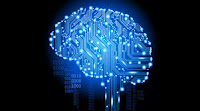Brain-Computer Interface
Sounds insane, right? Integrating the most complex organ of
the human body to a manmade framework built on logic- what else can possibly
sound cooler than this? The main purpose or the idea behind this was to make
possible the translation of human thoughts into expression via a digital
interface. Just imagine the immense help it could be to differently abled
persons, how easily they would be able to express their thoughts and ideas.
The reason we even contemplate this idea is because of the
way our brain works. Our brains are filled with neurons, individual nerve cells
connected to one another via dendrites and axons. The moment we sense
something, neurons start to fire and the impulse travels via electric signals
(potentials) which is generated as a result of the charged ions on the surface.
While most of the signal is transmitted, some of it escapes the cascade and can
be interpreted by scientists by amplifying. In BCI, this acts in the reverse
way too, i.e., we can stimulate the human brain into perceiving something we
want it to perceive using the same mechanism. The means to do it is simple-
electrodes, but the manner in which we can do is what will decide its efficacy.
Normally, electrodes are attached to skull but this result in reception of weak
and distorted signals. So the alternative is to implant minute electrodes
inside the skull, at the surface of brain, which again has its own advantages
as well as disadvantages.
Well, we cannot say such kind of systems don’t exist now. The
most apt example would be the chair of the great scientist Dr. Stephen Hawking.
Professor Hawking’s chair is not exactly an example of an
interface between brain and computer. However, currently it is as close to the
concept as it gets. The motorized wheelchair of Professor Hawking is designed
with cutting edge technology to suit his condition. As it is known, Professor
Hawking suffers from amyotrophic lateral sclerosis
(ALS), a rare motor neuron disease, in which one’s neurons in the brain start
deteriorating resulting in muscle twitching and their gradual degradation. This
ultimately causes several problems like difficulties in swallowing, speaking,
moving and eventually breathing. His chair is custom made to suit this unique
condition of his and is fitted with a Lenovo Yoga 260, powered by an Intel ®
Core i7-6600U processor and 512GB solid-state drive operating on Windows 10.
The main interface to the computer is through an open source program ACAT,
written by Intel. There is a sensor located in the professor’s cheek which
allows him to operate the computer with ease. The cursor moves throughout the
virtual keypad and Professor Hawking stops it at the desired point using his
cheek muscle movement. However, this took him a lot of time to compose lectures
or write papers. Recently, SwiftKey has collaborated with Intel on a program in
which they have generated a model which predicts the word the professor needs
next. This contextual prediction software is developed after thorough study of
the professor’s papers, articles and journals to get an idea of the vocabulary
he uses. Quoting Joe Osborne, SwiftKey’s SDK team lead, who led our work on
this project, “By understanding the way he uses language, SwiftKey’s technology
makes it faster and easier for Stephen to communicate, leaving him more time to
consider the secrets of the universe.”
Now, the major question to take this revolution further is-
Can the integration of brain with a computer which is basically binary, be
possible? Can we actually someday be able to digitize our thoughts? Well in my
personal opinion, I would say why not? I mean, a few of hundred years ago
nobody could have even thought of mobile phones but the still came anyway.
The point I am trying to make is that we are not far away
from the day where the integration of the human brain to a computer would be
possible. It is said that the universe is condensed in our brain. What if we
can use our brains to the fullest capacity after we digitize it? We may just be
able to decode secrets of the entire universe. And nevertheless, we may just be
able to evolve as a species…..
Written by
Divyajyoti Biswal





Oh Yeah ! Kan lekhicha ma 👍👍👍
ReplyDeleteThank you for appreciating. We would also like to know what you thought of the content and how our future writings can be improved. Once again, we heartily appreciate your compliment.
DeleteThought is appreciable .. You have explained well. All d best
ReplyDeleteThank you very much. We look forward to posting more innovative ideas and their possible future prospects. Thanks for letting us know how you felt.
Delete